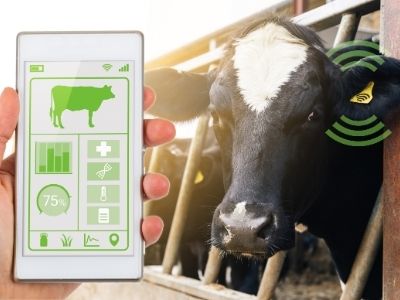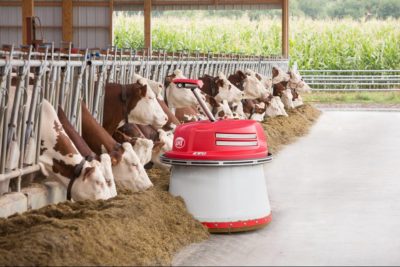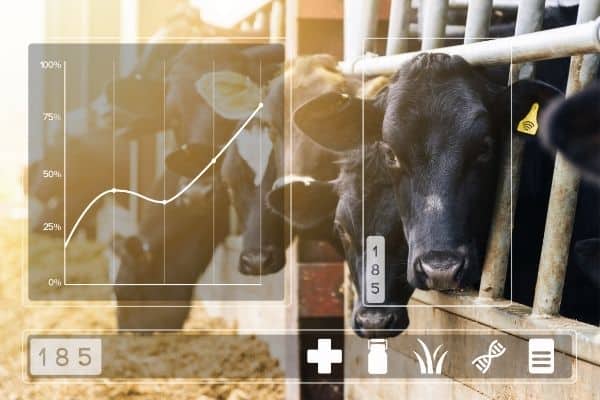As the world’s population continues to increase, so does the demand for milk. Despite the number of cows and dairy farms globally, dairy farmers are struggling to keep up with the demand. Luckily, many modern methods and technologies help dairy farms get the most from their cows and avoid wasting resources.
The automated dairy farm is the future of dairy farming. Some of the technologies being utilized by modern dairy farmers include:
In this article, we’ll look at each of these methods and more as we explore the ins and outs of an automated dairy farm.
Geofencing: High Tech Animal Tracking
In a general sense, geofencing means creating a virtual boundary around a physical geographical area using RFID or GPS technology. But how does this apply to dairy farming?
According to one study, geofencing is “used to track down animal health and other key behavior to increase output and overall animal wellness.”
The cows are outfitted with special collars, somewhat like shock collars; but, instead of delivering a shock to the cow if it leaves the geofenced area, it sends an alert and allows the farmer to track the cow’s location.
This smart technology allows the farmer to keep tabs on the cows and makes it easier to find them if any of them wander off. It also allows the farmer to keep a virtual eye on the cows while they are within the geofenced area, monitoring their general health and well-being.
Tagging and Monitoring Livestock
There are many different "smart tags" available to dairy farmers. These tags can have many different functions, including location tracking, health monitoring, and producing a record of everywhere the cow has been during its life.

These functions lead to a range of important implications. Each tag serves as a unique ID and allows the dairy farmer to know where each cow is at all times. This can reduce the incidence of stolen cows, help farmers find cows that have wandered off, and alert farmers to any concerning health changes in their cows.
In turn, these benefits will result in healthier cows, optimization of resources, and ultimately, better milk production and financial gain.
Many of these tags are solar-powered, so the dairy farmers never have to worry about changing batteries. Some are also able to turn themselves on and off as necessary.
These tagging and monitoring systems utilize cloud-processing and triangular positioning technologies, enabling them to use the least amount of power possible without skimping accuracy. The results have been promising, as smart tags appear to be a useful and financially efficient way to monitor individual cows no matter how large the farm may be.
Reproductive Management in Automated Dairy Farming
As the demand for milk increases, one of the most direct ways for dairy farmers to meet that demand is through reproductive management. Reproductive management encompasses two main goals: increasing the number of cows on the farm and improving the genetic quality of the cows.
What does this mean? And how is it accomplished?
Obviously, having more cows on the farm will increase milk production. But encouraging the reproduction of cows with the right genetic traits can be even more beneficial. Breeding not only for milk production but also for increased fertility, longevity, and overall health will produce the best results long-term.
There are various smart technologies to aid in reproductive management on dairy farms, including:
Nutrition and health management, as well as disease control, also play large roles in reproductive management. We’ll take a closer look at these aspects of automated dairy farming in the following sections.
Automated Health Management
Keeping cows healthy and separating unhealthy cows from the rest of the herd are both important aspects of dairy farming. But these can both be difficult tasks at large farms with large amounts of livestock.
Automated health management tools help farmers keep track of each cow by tracking their behavior, monitoring their health, and quickly alerting the farmer if changes or potential diseases are detected.
Below, we’ll take a closer look at two aspects of health management: automated administration of injections and nutrition management.
Automated Administration of Injections
Once a cow has been identified as having a disease, there is still the question of how to treat it. On large farms, several cows may need treatment at once, and treating them can be a time-consuming process.
To combat this problem, the US-based Pharm Robotics developed an automated robotic system for administering injections to sick cows. The robot uses cameras and RFID technology to pinpoint cows in need of injections. It can then gently restrain the cow and administer the injection, requiring no effort or assistance from dairy farmers.
Nutritional Management
To get the most out of each cow, dairy farmers must find a way to provide the most balanced nutritional options at the lowest cost possible. This can be a challenge, but some feeding methods have made it easier in recent years.
One feed option, in particular, Purina Animal Nutrition with NutriTek, claims to increase milk production and the overall health of cows. Using a specific fermentation technology, this feed contains greater amounts of antioxidants and other nutrients to help cows reach their peak energy and production levels.
Smart Sterilizers Help Clean Up
Smart sterilizers work in several different ways. Some emit UV radiation, while others emit disinfectant spray. Some are small and made for personal use, while others are used to sterilize homes, buildings, and even hospitals.
While the use of smart sterilizers in dairy farming is a relatively new idea, it is a great way to cut down on viruses and bacteria around the farm. Smart sterilizers can purify the air, water, and surfaces, and some may track and record information about viruses and bacteria.
It makes sense, then, that using smart sterilizers on dairy farms would improve the health of both animals and staff and reduce the incidence of milk contamination and spoilage. This, in turn, would lead to greater production and increased income.
Automatic Food and Water Supply
Cow’s milk is nearly 87% water, so ensuring the cows have an adequate water supply is crucial to milk production. Obviously, dehydrated cows will produce less milk, but such factors as air humidity and moisture content in the feed can also play a role.
Smart water tanks are often used on dairy farms. These tanks regulate the water at an ideal temperature for drinking and maintain the water level, so the tank never runs dry. Some of these tanks may also filter and purify the water as needed.
In addition to water, proper feeding is also necessary to maintain maximum milk production. If cows are overfed, they may build up an excess of nutrients in their bodies, which may produce toxic or detrimental effects. On the other hand, underfeeding will negatively impact milk production and, over time, will cause the cow’s health to deteriorate.
Automatic Feeders
Because of the time it takes to feed large numbers of cows, automatic feeding systems are gaining popularity among dairy farmers. Some systems, like the DeLaval Optifeeding system in Sweden, may save farmers as much as three hours of labor each day while also improving food storage and efficient feeding techniques.
How do these automatic feeders work?
Many of them look like large enclosed vats or tanks which hold the feed, keeping it stored in a cool, dark, and dry environment. The system then measures, mixes, and dispenses the feed automatically, providing just the right ratios and blends for each cow or group of cows.
Automated feeding systems reduce the amount of waste, saving the farmers money spent on feed while also saving them time spent on blending and distributing the correct rations.

What’s more, most feeders don’t have to be refilled during peak times, further saving the farmers time and hassle. The systems can be set to feed different groups of cows at different times based on their nutritional needs.
With so many features and functions, automatic feeders may be one of the best smart farming resources available.
Robotic Milking
Robotic milking machines are beneficial for farmers and cows alike. Many of these machines are completely automatic. They attract the cows with feed, then clean the teats and begin automatically milking the cows.
This fully automated process frees up a lot of time for the dairy farmers. It also benefits the cows by allowing them to be milked at their leisure--they choose when to approach the machine throughout the day.
While robotic milking machines are used primarily by smaller dairy farms right now, the trend will likely begin to include larger farms as we move into the future and the technology becomes more commonplace.
According to Norfolk Daily News,
“Dairy equipment suppliers estimate that by 2025, up to half of all dairy cows in the U.S. will be milked by machine.”
Not only do robotic milking machines allow dairy farmers more free time throughout the day, but they are also highly efficient. They may save the farmers more money over time by reducing wastage and limiting the need for hired help.
Of course, it may take some time and effort at first to help the cows get used to the process of being milked by a robot. They may initially shy away or act aggressively around the machines.
But this, too, will likely improve over time as milking robots become the norm. Indeed, on farms that use milking robots, the cows eventually get used to them and come to expect what’s coming when they go into the milking barn where the robots are kept.
Cooling Tanks
Milk cooling tanks are not new in the world of dairy farming. They are used to cool the milk quickly to its ideal temperature before storage to reduce the threat of the milk spoiling. But as with every aspect of the modern world, innovators are looking for ways to make milk cooling tanks more efficient, effective, and automated.
DeLaval offers a milk cooling tank system that can reduce energy usage by 70% during the milk cooling process. The system doesn’t just cool the milk; it actually pulls the heat out of it, then recycles the heat to warm water for other uses around the dairy farm.
Each milk cooling system is tailored to the specific needs of the farm, no matter how big or small the farm may be. They come with efficient, built-in cleaning systems to prevent contamination and spoilage, and they cool the milk rapidly in order to recycle the heat. These milk cooling systems are ideal for use with robotic milking machines.
The machine offers a pre-cooling phase where the milk is cooled as it’s pumped through the pipes toward the storage area. This is the point at which most of the heat is pulled from the milk, in turn, heating the water used to cool it, which can then be used to water the cows or for other uses.
After the pre-cooling process, milk is pumped into a chiller, where it is further cooled to the desired temperature. After this process, it is ready to be pumped into milking trucks and stored.
Smart Manure Management
It has been reported that each cow produces roughly 120 pounds of manure every day. When you consider that manure is a major source of methane and other greenhouse gases, it’s easy to understand why innovations in manure management are considered essential moving forward.
But what can be done to improve the way manure is managed on dairy farms?
To start, manure is an excellent fertilizer. Any dairy farm that grows its own feed can conceivably make use of the manure as it’s produced, maintaining a cycle that prevents long-term storage of the manure. This, in turn, prevents the greenhouse gases from developing as much and being released into the atmosphere, thus reducing negative impacts on the environment.
The Smart Manure Aeration System allows dairy farmers to use the manure as they need it while also preventing the build-up of dangerous gases during storage. The system is cost-efficient, hassle-free, and produces ready-to-spread manure with an even distribution of nutrients. In essence, it manages the manure to create an even more beneficial fertilizer.
Another option is to use an anaerobic digester, which captures the methane from the manure and makes use of it as natural gas. While this doesn’t completely eliminate the release of greenhouse gases, burning natural gas is much more efficient than simply releasing methane into the atmosphere.
End-to-End Data Analytics for Management
Any dairy farm with large numbers of cows and various smart technologies will likely need a way to keep track of all the information gathered and generated. For example, if a farm utilizes geofencing, various types of automatic feeders, health sensors, robotic milkers, and automatic cooling tanks, all of these technologies will be generating data.
There may be so much data, in fact, that it becomes overwhelming.
What is the dairy farmer to do with all this data?
Smart data analytics systems may provide a solution. Systems like Farmtree can help dairy farmers integrate the various smart technologies in use around the farm and compile valuable data across all of the technologies.
These end-to-end data systems can compile health information on all the cattle, create figures regarding average milk production, and even let farmers know which cows produce the most milk.

Like other smart technologies, these data systems do the work for the farmers, compiling necessary data in an easy-to-use format, so the farmer doesn’t have to go through the hassle of tracking down all the data themselves.
These systems can free up lots of time for the farmers so they can focus on doing the work that needs to be done around the farm without stressing over the data. Less stress produces happier farmers, in turn allowing the farm to function more efficiently.
Final Thoughts
As you can see, there are many methods available to ensure that the world doesn’t run out of milk. Many large dairy farms are already putting some or all of these methods into practice.
Automated dairy farming is the way of the future. Whether through reproduction management, tagging and monitoring, or automated feeding and watering, getting the most from each cow and ensuring no milk is wasted is absolutely essential.
The need for milk isn’t going away, so dairy farmers must meet that need without negatively impacting the economy, the environment, or the health of the cows. These smart, automated technologies allow the farmers to do just that.

